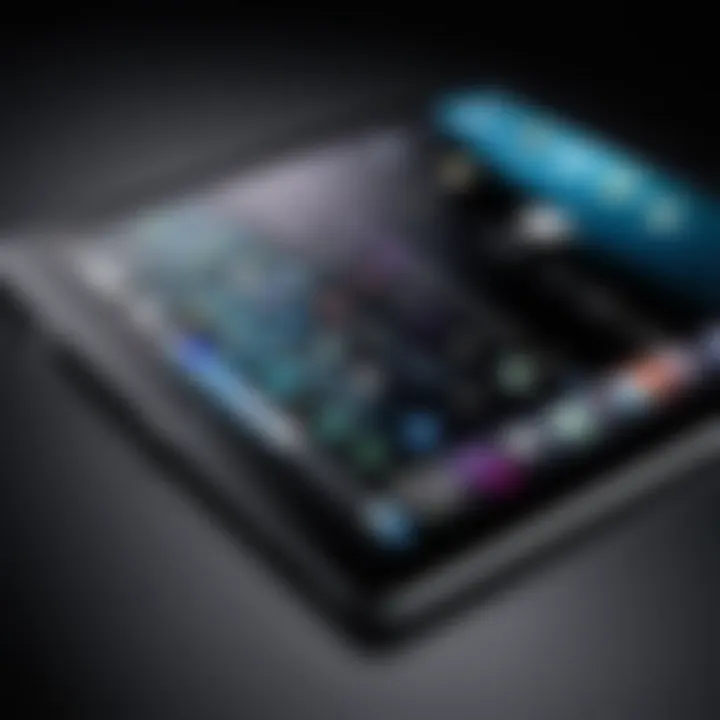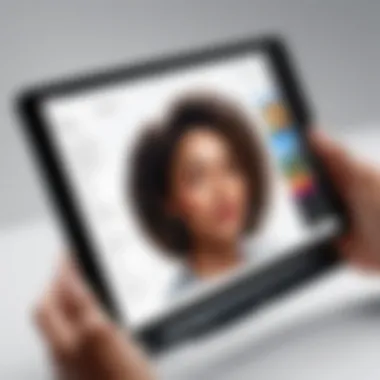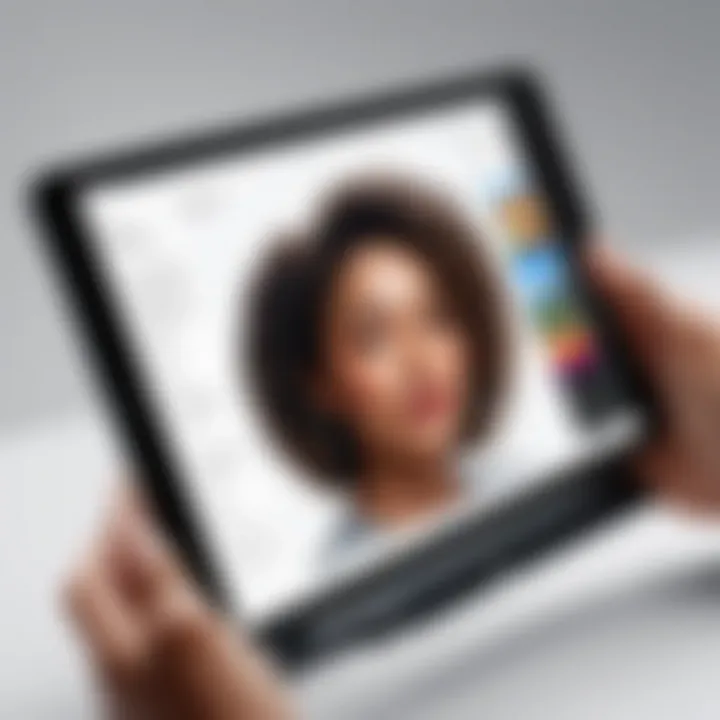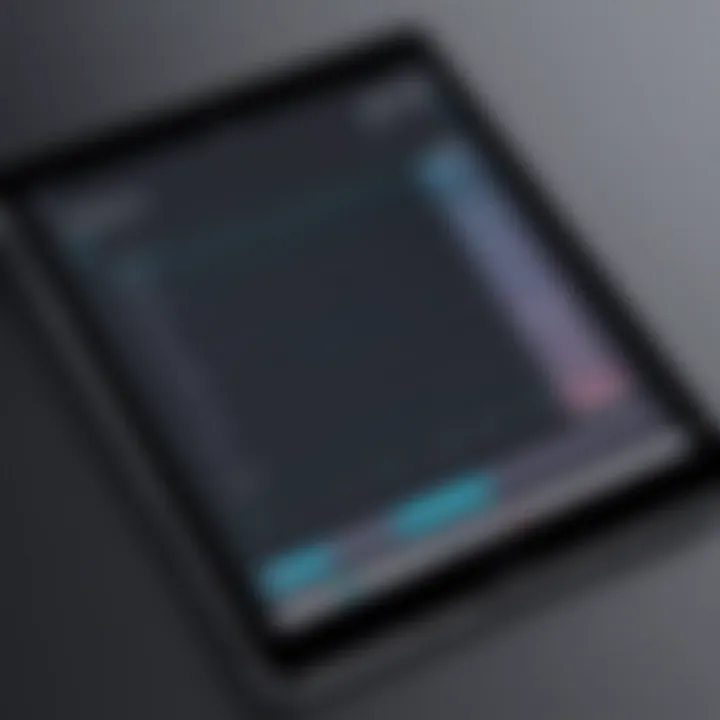Exploring the Apple iPad for Drawing: A Comprehensive Guide


Intro
The Apple iPad has become a prominent tool among digital artists and illustrators. Its portability, sleek design, and powerful capabilities make it an appealing choice for both hobbyists and professionals alike. This guide provides a thorough exploration of how the iPad serves as a drawing tool. It aims to offer insights into its specifications, performance, and software that can elevate digital artistry.
By examining the various aspects of the iPad, including hardware and accessories, we can appreciate its potential. Whether you are an experienced designer or just starting out, understanding these elements will allow you to maximize your creativity. As we delve into the capabilities of the Apple iPad, we will uncover key features and performance metrics that define its role in the creative community.
Prologue to Digital Drawing on Apple iPad
Digital drawing has transformed how artists create and share their work. The Apple iPad stands out as a leading platform for this creative process. With its advanced technology and user-friendly interface, the iPad streamlines digital artistry for both professionals and enthusiasts. This section delves into the relevance of the iPad for digital drawing, exploring its unique benefits and key considerations for artists.
One crucial aspect to cover is the hardware capabilities of the iPad. Features such as high-definition displays and compatibility with the Apple Pencil permit an intuitive drawing experience. Artists benefit from precision and responsiveness, which are essential for creating detailed art. Moreover, the portability of the iPad enables artists to draw wherever inspiration strikes, be it a coffee shop, a park, or their living room.
Another point of importance is the vast software ecosystem available for digital drawing. Applications like Procreate and Adobe Fresco provide powerful tools and features tailored for various styles and techniques. There is a sense of community surrounding iPad drawing, where users share resources, tips, and tutorials. This contributes to the learning and growth of digital artists.
Furthermore, the iPad serves as a bridge between traditional and digital techniques. Artists can leverage skills developed in conventional media and apply them in a digital format. The process becomes less about abandoning old methods and more about enhancing them.
Assessing the Hardware Specifications
Understanding the hardware specifications of the Apple iPad is crucial for evaluating its capabilities as a drawing tool. The combination of display technology, processing power, and battery life contribute significantly to the overall user experience. When considering the iPad for digital drawing, one must assess these elements closely to ensure they meet the individual needs of artistry.
Display Technology
Liquid Retina Display Features
The Liquid Retina Display of the iPad is one of its standout features. This display technology benefits artists due to its high-resolution capabilities and wide color gamut. The key characteristic of the Liquid Retina Display is its ability to deliver vibrant colors and deep contrasts, which is essential for detailed graphical work. This ensures that every stroke of the pencil is represented accurately on screen. Furthermore, the seamless edges and minimal bezels enhance the immersive experience of drawing.
Another unique feature is the anti-reflective coating, which minimizes glare and allows for comfortable drawing in various lighting conditions. This characteristic positions the Liquid Retina Display as an excellent choice for both professional artists and hobbyists who require precision in their artwork.
Apple Pencil Compatibility
Apple Pencil compatibility is a critical aspect of the iPad's hardware. This accessory facilitates a natural drawing experience, enhancing the overall capabilities of the iPad for digital artistry. A notable characteristic of Apple Pencil is its responsiveness and precision, making it an ideal tool for artists who value detail. Artists can utilize it to achieve fine lines and subtle gradients, which enhances creative expression.
The unique feature that sets Apple Pencil apart includes its pressure sensitivity and tilt functionality. These attributes allow for dynamic line variation, mimicking traditional drawing instruments. However, it is essential to consider that the experience may vary depending on the iPad model, as not all models support the second generation of Apple Pencil, which offers improved features.
Processing Power
A-Series Chip Overview
The A-Series chips in the iPad play a significant role in the device's processing power. These chips are designed to handle intensive tasks, such as high-resolution drawing applications, making them suitable for professional use. The primary characteristic of the A-Series chip is its efficiency in managing multiple applications simultaneously, which is vital for artists working with layers in their drawings.
A unique aspect of the A-Series chip is its neural engine, which enhances performance in machine learning tasks. This feature can potentially streamline workflows in apps that utilize AI, such as those for image recognition or enhancing artwork. For digital artists, this fast and efficient processing is a major advantage, as it reduces lag time during creative sessions.
Performance Benchmarks
Performance benchmarks are essential for understanding the iPad's capabilities in real-world usage. These benchmarks often gauge speed, multitasking ability, and graphic performance under different scenarios. The key characteristic of these benchmarks is that they provide empirical data regarding how well the iPad can handle complex applications like Procreate or Adobe Fresco.
When analyzing performance benchmarks, the unique feature is the ability to assess the iPad against previous generations or competing products. This information is vital for potential buyers and can guide them in making an informed decision about the suitability of the iPad for digital drawing purposes.
Battery Life and Portability
Charging Specifications
Charging specifications directly influence the usability of the iPad for drawing. The charging methods available, such as the USB-C port on newer models, offer fast charging capabilities. This means that artists can recharge their device quickly during breaks or short sessions. A primary characteristic of the iPad's charging specifications is the longevity of battery life under continuous usage, which can reach up to ten hours.
This value greatly benefits artists who frequently travel or work remotely, as it allows for extended drawing sessions without the need for constant power access. The quick charge and long battery life are essential for maintaining productivity.
Weight and Dimensions
Weight and dimensions of the iPad also affect its portability and user experience. The slim profile and lightweight nature of the device allow artists to carry it easily without added bulk. A notable characteristic of its design is how it fits comfortably in hand during drawing sessions. This ergonomics enhance the tactile experience for artists.
The compact size of certain iPad models means they can easily fit into bags, making them suitable for artists on the go. However, the dimensions also mean that the drawing space may feel limited for some users, depending on personal preference and style.


Apple Pencil: The Essential Drawing Tool
The Apple Pencil plays a critical role in enhancing the drawing experience on the iPad. It is designed to work seamlessly with the device, providing artists with a level of precision that fundamentally changes digital drawing. This tool not only imitates traditional drawing instruments but also adds functionality to modern applications for graphic design and illustration.
Overview of Apple Pencil Generations
The Apple Pencil has evolved through two generations, each bringing specific advantages that enhance the drawing experience.
First Generation Features
The first generation of the Apple Pencil was a game-changer for digital artists. It offers a pressure-sensitive tip that allows for variances in line thickness depending on how hard the user presses. This feature is essential for replicating the nuances of traditional drawing techniques. Additionally, the first generation is compatible with various iPad models, making it accessible for a broad range of users. Its design includes a Lightning connector for charging, which, while practical, can be seen as somewhat cumbersome.
Second Generation Enhancements
With the introduction of the second generation, users discovered several improvements. It features a flat edge design that attaches magnetically to certain iPad models for easy storage and charging. This eliminates the awkward charging method of its predecessor. Moreover, it boasts improved latency and responsiveness, directly impacting drawing fluidity. Artists often prefer this model due to its refined balance and enhanced capabilities, making it a vital component for serious digital art enthusiasts.
Pressure Sensitivity and Tilt Functionality
The sensitivity of the Apple Pencil is a pivotal aspect of its performance, significantly affecting the quality of drawings.
How Sensitivity Impacts Drawing
Pressure sensitivity enables artists to create varied line weights and textures, essential for dynamic artwork. The more pressure applied, the thicker the line produced. This characteristic aids in achieving depth and detail in illustrations, aligning closely with traditional art forms. Understanding how to manipulate pressure allows artists to push the boundaries of their creativity, thus enhancing the overall artistic expression.
Use Cases in Art Applications
Numerous art applications benefit from the Apple Pencil's advanced features. Programs like Procreate and Adobe Fresco utilize pressure sensitivity to offer a range of brushes and tools that mimic real-world painting and drawing techniques. Users can experience sketching, inking, and painting in ways that feel natural and intuitive. This versatility makes the Apple Pencil an indispensable tool for digital artists, allowing for a diverse range of styles and techniques.
Battery and Charging Considerations
Battery life and charging methods are vital factors that affect the usability of the Apple Pencil.
Charging Methods
The first generation charges through a Lightning connector, which can be inconvenient as it protrudes from the iPad while charging. In contrast, the second generation offers magnetic attachment, which enables hassle-free charging directly on the iPad. This design is more user-friendly and ensures that the Apple Pencil is always ready for use.
Battery Performance Metrics
Battery life for both generations is generally satisfactory for daily art tasks. Users can expect hours of continuous use on a single charge, making it suitable for long drawing sessions. However, frequent users must consider how often they recharge the device. Users report that while the charging duration is brief, maintaining a consistent cycle is essential for uninterrupted workflow.
"The Apple Pencil changes how artists interact with digital canvases, making it an essential tool for those serious about their craft."
Software Ecosystem for Digital Drawing
The software ecosystem surrounding digital drawing on the Apple iPad plays a crucial role in realizing the device's full potential as an artistic tool. The applications available not only impact the creative process but also define the overall experience for users, particularly professional and hobbyist artists alike.
As more artists transition to digital platforms, understanding the software options available becomes essential. A rich ecosystem provides varied functionalities, catering to different styles and workflows. The ease of use and the degree of customization offered by these applications can significantly influence productivity and creativity.
Overview of Leading Drawing Applications
Procreate Features and Usage
Procreate has gained a strong following among iPad users due to its powerful features and user-friendly interface. It allows for an intuitive drawing experience that closely mimics traditional mediums. A standout characteristic is the vast array of brushes and tools available, which artists can customize to suit their specific needs. This flexibility makes Procreate a widely beneficial choice for artists looking for versatility in their toolkit.
One unique feature is its support for high-resolution canvases. This allows artists to work on detailed illustrations without worrying about losing quality. However, this could also lead to performance issues on older iPad models if the hardware cannot handle the higher demands.
Adobe Fresco Capabilities
Adobe Fresco is yet another strong contender. It is designed with a focus on digital painting and drawing, incorporating both raster and vector capabilities. A key characteristic of Adobe Fresco is its Live Brushes, which simulate real paint blending and brush effects. This level of realism appeals to many artists seeking a more authentic painting experience.
However, users might find some disadvantages, such as limited features compared to Procreate. While Adobe Fresco integrates well with Adobe Creative Cloud, it may not offer the same depth of customization, which could be a setback for more advanced users.


Evaluating Application Performance
Rendering Speed and Responsiveness
The rendering speed of drawing applications significantly affects user experience. Quick and responsive applications reduce lag, allowing for a seamless drawing experience. This is vital for artists who rely on precision and fluidity.
A notable characteristic of rendering performance is its impact on brush responsiveness. In applications where rendering is slow, the artistic flow may feel interrupted. This can frustrate users, especially during detailed work. Therefore, choosing applications with a reputation for responsiveness, like Procreate, adds value to the digital drawing experience.
Tool Availability and Customization
Tool availability is another essential consideration. A diverse selection of tools allows artists to experiment with different styles and techniques. Customization of these tools can elevate an artist's work and allow for a personal touch in the artwork.
Applications like Procreate shine in this aspect, offering settings that adapt to many artistic preferences. However, a crowded tool palette can overwhelm beginners, making the initial learning phase potentially challenging.
Integration with Other Software
Cloud Storage Options
Ease of access to saved works is crucial for artists, especially those who collaborate or switch between devices. Cloud storage options facilitate this by allowing users to save their work and access it from any compatible device.
Services like iCloud and Dropbox integrate seamlessly with many drawing apps, broadening the accessibility of the saved files. However, reliance on an internet connection can pose issues for those working in areas with limited access.
Cross-Platform Compatibility
Cross-platform compatibility ensures that artists have flexibility in their workflows. This characteristic allows users to collaborate with professionals using different operating systems or to continue projects on other devices.
Applications such as Adobe Fresco offer strong integration across multiple platforms, allowing users to start a project on the iPad and complete it on a desktop. Yet, not all applications support full compatibility, potentially leading to user frustration when attempting to switch devices.
Ultimately, a well-rounded software ecosystem enhances the Apple iPad's capabilities as a drawing tool, offering creative solutions and diverse functionalities suited for artists. The choice of applications directly influences user experience, output quality, and creative satisfaction.
User Experience: Navigating the Interface
User experience is crucial in drawing applications on the Apple iPad. A well-designed interface can significantly enhance the creative process. When artists use digital tools, they want immediate access to features without distraction. Therefore, how users interact with the device directly impacts their ability to create art effectively.
Interface Design Usability
Layout and Accessibility Features
The layout of the drawing applications on the iPad is designed with users in mind. This design facilitates fluid navigation between tools. Key characteristics include easily identifiable icons and responsive touch gestures. Such elements help in quick switching between brushes and color palettes.
The accessibility features make these apps stand out in the competitive market. For instance, users with diverse needs can find customizable settings. This user-centric approach enhances overall usability. These considerations are vital for ensuring that everyone can take full advantage of the iPad's capabilities.
One unique feature is the ability to customize shortcuts for frequently used tools. This functionality streamlines the workflow, saving time during the creative process. However, for new users, too many options might be overwhelming.
Customization Options
Customization options offer artists a personal touch in their digital workspace. Users can adjust settings according to their preferences, making the drawing experience unique. This flexibility is beneficial, as every artist has different requirements.
A standout characteristic of these options is the ability to modify interface colors and layouts. This allows users to create a comfortable and inspiring working environment. Moreover, having customizable brushes and tool settings fits various artistic styles.
However, not all users may find extensive customization easy to navigate, particularly beginners. Nonetheless, the advantages often outweigh the disadvantages for seasoned artists who appreciate tailored experiences.
Learning Curve for Beginners
Educational Resources
The educational resources available for iPad drawing applications play a vital role in the user experience. Online tutorials and guides help artists quickly understand the tools at their disposal. These resources often cater to different skill levels, from beginners to advanced users.
A key characteristic of these resources is their accessibility. Many of them are free and easy to find, which is attractive to new artists. Users can quickly learn essential techniques without investing a lot of money. Moreover, video tutorials offer visual explanations that can enhance understanding.
However, sometimes these resources can be scattered across platforms, making it hard to find comprehensive guides. New users may find it challenging to decide where to start.


Community Support and Forums
Community support is another significant aspect of the user experience on the iPad. Drawing forums and social media groups allow artists to share tips and ask questions. This collaborative environment fosters growth and encouragement among users.
A major characteristic of these communities is their diversity. Artists of all skill levels contribute, making it a rich resource for various perspectives and styles. Forums often have structured categories that help users find specific topics quickly.
Nevertheless, while community engagement is beneficial, it can sometimes lead to information overload. Beginners might feel intimidated by the vast amount of advice and contrasting opinions available. Despite this, community support remains an invaluable asset for many users, providing both inspiration and guidance.
In summary, the user experience with the iPad's drawing applications is centered around intuitive design and robust support resources. This aspect not only empowers users but also enhances their creative journey.
Pros and Cons of Drawing on the iPad
Understanding the advantages and disadvantages of drawing on the iPad is crucial for making an informed decision for any artist. The Apple iPad market offers unique benefits that cater to digital artists while also presenting certain challenges. This dichotomy informs both new and veteran users about how best to leverage the iPad for their artistic pursuits. Practically, it can impact everything from workflow efficiency to the choice of tools.
Advantages of Using iPad for Art
Portability and Convenience
The portability of the iPad stands out in the realm of digital art tools. Artists can easily transport the device, allowing them to work anywhere, whether it is at home, in a coffee shop, or outdoors. This constant accessibility encourages spontaneity in creativity, as ideas can be captured on the go.
A key characteristic of the iPad is its lightweight design which doesn’t compromise on functionality. Artists no longer need to carry heavy equipment, such as laptops or large drawing tablets. The iPad, along with the Apple Pencil, is easy to handle and use, which makes it popular among both amateurs and professionals.
However, while the iPad offers significant convenience, it can also lead to distractions if artists find themselves pulled towards social media or other applications during their work sessions.
Versatility for Various Art Styles
The versatility offered by the iPad is another important aspect to consider. Its range of applications, from Procreate to Adobe Fresco, support a multitude of art styles and techniques. Whether one is drawing comics, painting, or practicing digital illustration, the iPad can accommodate it all effectively.
This versatility draws a variety of users, as it meets different artistic needs in one device. Artists can experiment with layers, brushes, and effects that suit their specific styles without being restricted by hardware limitations.
Nonetheless, while this adaptability is beneficial, it may also overwhelm artists who prefer a more straightforward approach. The vast options can sometimes lead to indecision on what tools or techniques to use.
Limitations and Challenges
Screen Size Constraints
One key limitation of the iPad is the screen size. While models such as the iPad Pro offer larger displays, many of the devices come with smaller screens that can be limiting for detailed work. Artists focusing on intricate designs may find the real estate insufficient for their needs, which could affect the quality of their final pieces.
The pros of portability might not outweigh the cons when dealing with limited visual space. Artists might feel pressured to zoom in excessively, which can disrupt their flow. This aspect is often a balancing act for those who value both convenience and workspace.
App Ecosystem Limitations
Another challenge is the constraints of the app ecosystem. Although there are a variety of drawing applications available, not every software is optimized for the iPad experience. Some may lack essential features that artists might find on desktop versions.
Additionally, subscription-based models can also deter users who are considering multiple applications. Some may not find the ongoing cost justifiable for their artistic practice. This limitation underscores the importance of researching specific applications beforehand to ensure they meet the artist's requirements and expectations.
"While the iPad opens new doors for many artists, understanding its limits is essential for maximizing creativity."
Culmination and Recommendations
In the realm of digital artistry, the Apple iPad stands as a pivotal tool for both professionals and enthusiasts. This guide has navigated through various features, highlighting its hardware, software, and accessories tailored for drawing tasks. The focus on the iPad's capabilities underscores its importance in today’s creative landscape. The iPad not only enables artists to create with precision but also provides an impressive platform for dynamic artistic exploration.
Understanding the drawing potential of the iPad can greatly influence an artist's workflow and productivity. As covered, the high-quality Liquid Retina display, equipped with Apple Pencil compatibility, enhances the drawing experience. Additionally, this portable device offers processing power that can rival traditional desktop setups, making it versatile for different types of art styles and tasks. The applications available create an enormous ecosystem that caters to a wide array of techniques.
Artists must consider key factors when contemplating the iPad as their primary drawing tool. The advantages of portability, a rich software landscape, and the creative freedom it affords cannot be understated. However, limitations such as screen size may influence some users. Balancing these pros and cons informs an artist's decision-making process regarding digital creation.
Final Thoughts on iPad Drawing
Upon reflecting on the journey through the capabilities of the iPad for drawing, it becomes evident that this device is not merely a tablet but a sophisticated instrument for creativity. The seamless interaction between hardware and software heralds a new age for artists, where traditional tools blend with technology. As users continue to explore the depth of applications like Procreate and Adobe Fresco, they find a customizability that enhances their personal artistry.
The growing community around the iPad’s drawing tools also plays a significant role in this experience. Forums and platforms where users share tips and resources foster a collaborative environment, making it easier for newcomers to learn. This support system amplifies the value of the iPad for artists who seek connection and growth within their craft.
Future Trends in Digital Art Technology
Looking ahead, several trends are poised to shape the future of digital art technology, particularly as it relates to devices like the iPad. As augmented reality and virtual reality commence their integration into creative tools, artists will encounter means to visualize their work in immersive environments. This evolution propels creativity into new dimensions.
Furthermore, artificial intelligence is becoming increasingly significant in art applications. AI-driven tools provide artists with unique capabilities, such as style transfer and automated design suggestions. This not only accelerates the creative process but also offers artists a means to explore ideas beyond traditional boundaries.
Finally, the demand for portability paired with powerful performance will likely drive design improvements in future iterations of the iPad. With each model, users can expect enhancements that optimize their drawing experience while maintaining the convenience that the iPad is known for.



